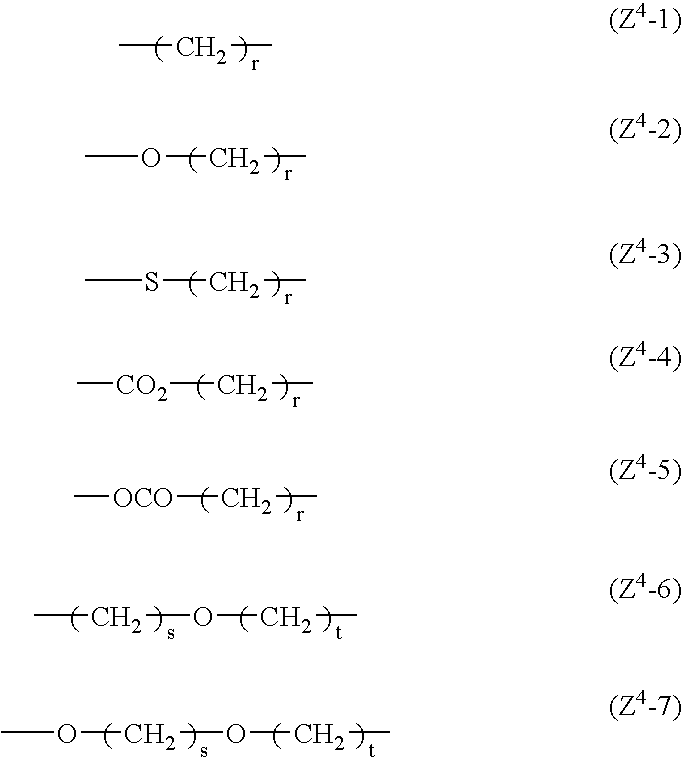Liquid-crystalline vinyl ketone derivatives and their polymers
a technology of liquid crystallinity and vinyl ketone, which is applied in the field of liquid crystallinity compounds, can solve the problems of not fully satisfying the characteristics of liquid crystallinity, not always good all acrylate polymers, optical anisotropy, etc., and achieves good compatibility with other compounds, good mechanical strength, good crystallinity, good mechanical strength, good mechanical strength
- Summary
- Abstract
- Description
- Claims
- Application Information
AI Technical Summary
Benefits of technology
Problems solved by technology
Method used
Image
Examples
example 1
Production of 4-(4-pentylbenzoyloxy)phenyl Vinyl Ketone
Compound (1-5-11) was produced according to the following reaction scheme:
Step 1, Production of 2-chloroethyl 4-methoxyphenyl Ketone (b)
A mixture of anisole (a) (230.8 g), aluminium chloride (298.8 g) and methylene chloride (500 mL) was cooled in an ice bath. To this, dropwise added was a mixture of 3-chloropropionyl chloride (271 g) and methylene chloride (200 mL) while the inner temperature was kept at 10° C. or lower. The cooling bath was removed, and this was heated with a mantle heater for 30 minutes under reflux, and then the reaction liquid was poured into a mixture of ice and hydrochloric acid. This was transferred into a separating funnel, and the separated organic phase was washed with water. The solvent was evaporated away under reduced pressure, and the residue was recrystallized from Solmix. This was taken out through filtration and dried to obtain 72.6 g of colorless crystals, 2-chloroethyl 4-methoxyphenyl k...
example 2
Production of 4-(4′-heptyl-1,1′-biphenyl-4-carbonyloxy)phenyl Vinyl Ketone (1-13-8)
The compound (1-13-8) was produced according to the following reaction scheme:
A mixture of 4-hydroxyphenyl vinyl ketone (c) (1 g), 4′-heptyl-1,1′-biphenyl-4-carboxylic acid (1.8g), DCC (1.9 g) DMAP (0.1 g) and methylene chloride (30 mL) was stirred at room temperature for 12 hours. The white solid precipitated was filtrated out, and the solvent was evaporated away from the filtrate. The residue was dissolved in ethyl acetate, and washed with aqueous 2 M NaOH solution and then with water. The solvent was evaporated away, and the residue was purified through column chromatography (eluent: toluene) and then through recrystallization (ethanol) to obtain 0.5 g of colorless crystals, compound (1-13-8). The NMR and MS spectra of the compound well support the structure thereof.
Phase transition points: C 118.8 Nem.
The compound (1-13-8) polymerizes at 120° C. or higher. Therefore, its clearing point wa...
example 3
Production of 4-(4-propylbenzoyloxy)phenyl Vinyl Ketone (1-5-10)
Using 4-propylbenzoic acid in place of 4-pentylbenzoic acid, compound (1-5-10) was obtained according to the method of Example 1.
Phase transition points: C 71.0 (Nem 69) I.
PUM
| Property | Measurement | Unit |
|---|---|---|
| Temperature | aaaaa | aaaaa |
| Temperature | aaaaa | aaaaa |
| Composition | aaaaa | aaaaa |
Abstract
Description
Claims
Application Information
 Login to View More
Login to View More - R&D
- Intellectual Property
- Life Sciences
- Materials
- Tech Scout
- Unparalleled Data Quality
- Higher Quality Content
- 60% Fewer Hallucinations
Browse by: Latest US Patents, China's latest patents, Technical Efficacy Thesaurus, Application Domain, Technology Topic, Popular Technical Reports.
© 2025 PatSnap. All rights reserved.Legal|Privacy policy|Modern Slavery Act Transparency Statement|Sitemap|About US| Contact US: help@patsnap.com



